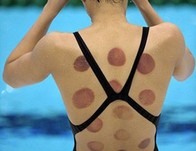Our Modalities
Manual Trigger Point TherapyMyofascial Trigger Point Therapy is a style of manual therapy that focuses on deactivating problematic trigger points in skeletal muscle. Trigger points are hyper-irritable spots within a taught band of muscle tissue that give rise to reproducable and familiar pain and can interfere with proper function.
During a session, focused pressure is applied through a variety of techniques in order to release and "deactivate" trigger points. Although this process can be painful at times, it often "hurts so good". Myofascial Trigger points can be treated manually with pressure or by dry needling techniques to get to hard-to-reach or "stubborn" trigger points. Acupuncture and Dry NeedlingAcupuncture can be traced back at least 2,500 years ago as a component of China's health care system. Acupuncture is a family of procedures involving stimulation of specific locations on or in the skin by a variety of techniques. The general theory of acupuncture is based on the premise that there are patterns of energy flow (Qi) which travel along certain channels (or meridians) through the body that are essential for health. Disruptions of this flow are believed to be responsible for disease and pain. The traditional theory of acupuncture is that the insertion of fine needles can correct imbalances of energy flow at identifiable points close to the skin.
The most common use of acupuncture is in the treatment of acute and chronic pain. Dry Needling, or Functional Dry Needling, or Orthopedic Acupuncture, can be understood as a modern western approach to acupuncture which purely considers pain and pathology from a biomedical point of view. Dry Needling is used to stimulate healing of ligament, tendon, deactivate myofascial trigger points, and remove fascial restrictions causing pain and dysfunction. According to modern science, the insertion of fine acupuncture needles in discrete areas can increase circulation locally and stimulate the nervous system triggering the release of neurotransmitters and hormones leading to stimulation of the brain and nerves which triggers the body to heal itself. Dry needling is a powerful tool and a very effective at treating myofascial pain and disfunction however, the treatment typically does involve some discomfort during and usually some soreness 24-48 hrs post treatment. |
IASTIMInstrument Assisted Soft Tissue Mobilization Techniques
Guasha is traditional Chinese medical treatment in which the skin is scraped to produce light petechiae (redness).
Cupping creates negative pressure or suction on the skin. The vacuum created in the cup brings blood and lymph to the underlying tissue.
Both of the IASTIM techniques of Guasha and Cupping are believed to stimulate new oxygenated blood flow to the treated areas, thus promoting metabolic cell repair, regeneration, healing and recovery. Electroacupuncture (EA) uses the same principles and points as the Western and Eastern needling methods, but it adds a microcurrent to the needle. The frequency of the current and the number of electrons that flow through the wire to the body are adjusted to achieve a desired effect of relaxing or stimulating tissue. The intention of electroacupuncture is to enhance the function of a specific Acu point and to activate different types of regeneration or pain modulation by stimulating the nervous system.
Kinesiology TapingKinesiology Taping is the use of elastic cotton tape with an acrylic adhesive with the intent of treating pain and disability from athletic injuries and a variety of other physical disorders. The tape is intended to aid stabilization and support of muscles, ligaments, tendons, and joints. Applications can also focus on fascia, the superficial lymphatic system, capillary system and nervous system. The way the tape is cut, the amount of stretch, and placement of the tape on the body will vary based on the type of tissues being treated.
|





